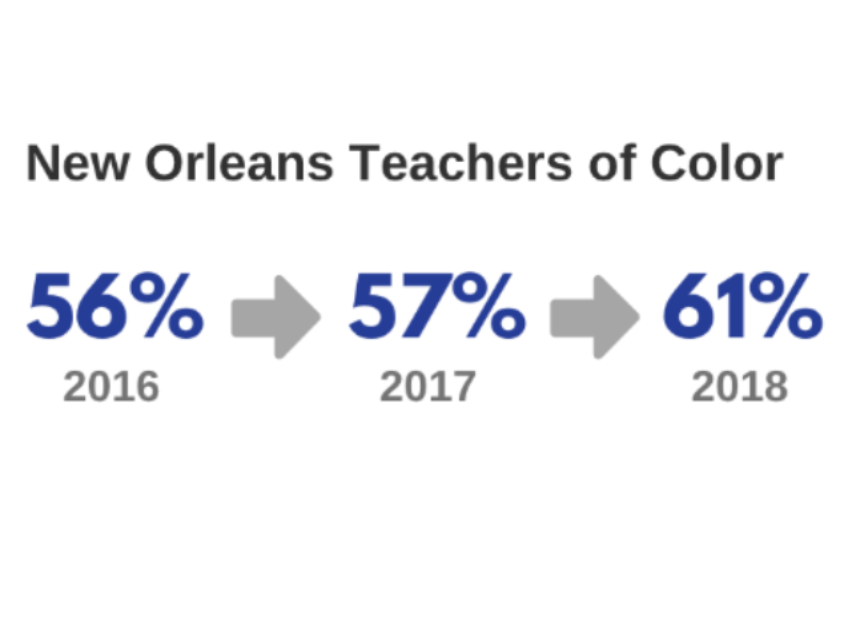In New Orleans, we want the very best teachers for our kids – regardless of demographics. We also recognize that our students are predominantly students of color and we need to prioritize recruiting and retaining a teacher force that looks like them. One report from Brown University showed that black students randomly assigned to a black teacher at least once between kindergarten and third grade were 13% more likely to enroll in college than their black peers who did not have a black teacher. Other research has found that students taught by a teacher of their own race had a 3-4 point increase in their test scores in reading and math. And we know the impact of great teachers of color goes beyond any test score; the ability of a student to see themselves in the leader in front of their classroom, for instance, holds great power.
In New Orleans, the percentage of our teachers that are people of color has increased steadily in the last three years, growing from 56% in the 2016-17 school year to 61% in 2018-19. The percentage of black teachers specifically has grown as well, rising from 50% to 53%. 
This is a higher percentage of black teachers and teachers of color than in the public schools of similar large urban parishes across Louisiana—Baton Rouge, Jefferson Parish, and Caddo Parish.
2018-19 Student and Teacher Demographics

Note: Data points include all public schools in a given parish.
We believe part of the reason New Orleans has growing percentages of black teachers and teachers of color more broadly is due to our city’s focus on training and recruitment of teachers of color. The majority of new teachers prepared by five local training programs supported by a federal SEED grant (Loyola University, the Norman C. Francis Teacher Residency at Xavier University, Relay Graduate School of Education, Teach NOLA, and Teach For America) over the past three years were people of color.
In one such program, the New Orleans chapter of Relay Graduate School of Education, 97% of today’s teachers-in-training are people of color. This is the result of a deliberate focus on the part of Dr. David J. Wallace, the Dean of Relay’s New Orleans program.
“Representation matters, now more than ever,” Dr. Wallace writes. “As we continue to diversify the teacher force here in New Orleans, we’ve been intentional about our recruitment efforts to ensure that the majority of our Relay student body represents the students we serve. Our PK-12 scholars need to be able to see themselves in front of the classroom, so that they can have an expanded view of what’s possible for them in the future. In other words, they can’t be what they can’t see.”
Historically Black Colleges and Universities (HBCUs) have been a key focus of the teacher recruitment efforts in New Orleans. Xavier University of Louisiana’s Norman C. Francis Teacher Residency (NCFTR) marked a groundbreaking partnership between an HBCU and our city’s local public schools. The NCFTR fellows earn their masters’ degrees in education while in “residency” in New Orleans public schools.
The five programs supported by SEED have been sending recruiters to find future educators from HBCUs across the South. They have recruited teachers from as close to home as Dillard University in New Orleans all the way to HBCUs in Atlanta. These programs know that students thrive when they see teachers that look like them, and they also know that their school partners are eager to hire diverse talent.
We see these efforts reflected in the demographics of our newest educators citywide. Fifty-six percent of teachers in their first three years of teaching are black, and 36% are white. We are excited to have these new teachers in our classrooms, and grateful to local training programs for their efforts to prepare teachers of color in particular.

As a city, we will continue our efforts to recruit great educators, particularly those of color, and retain them through long careers. Their impact goes beyond academics. At NSNO, our CEO, Patrick Dobard, has written about the effect of black educators on his own life. “I could see myself in them,” he wrote, “and in so doing, imagine a future for myself that looked like theirs. When I chose to become a teacher myself, it was in their footsteps.” We know that, across our city today, children are seeing themselves in their teachers. We hope that many of them follow in their footsteps, too.
